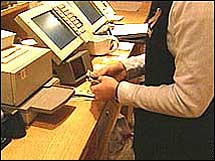|
Personal income, spending rose in January
Income gains top forecasts but spending still grew at a faster pace, leading to another month with a negative savings rate.
NEW YORK (CNNMoney.com) - Consumer spending came in a bit weaker than forecasts in January, according to a government report Wednesday, but it still grew faster than personal income, keeping the savings in negative territory for the eighth time in the last 10 months. The Commerce Department reported that personal spending rose 0.9 percent in the month, perhaps spurred by the warmest January on record. That's up from a 0.7 percent gain for December, which was revised lower. Economists surveyed by Briefing.com had forecast a rise to 1 percent.
The report also showed personal income increased 0.7 percent, up from the revised 0.5 percent rise for December. Economists had forecast 0.6 percent growth. The report had good news on the inflation front as the price paid by consumers for goods outside of food and energy rose at a 1.8 percent annual rate. That's down from the 1.9 percent gain the previous three months. The reading, known as the core PCE deflator, is a key measure watched by the Federal Reserve for signs of inflationary pressure, and economists and investors had been watching to make sure it stayed below the 2 percent level seen as the Fed target for inflation. "It gives the Fed a little more breathing room on interest rates, that's the most I can say," said Mark Vitner, senior economist for Wachovia. Most economists and investors agree that another quarter-percentage point rate hike at the Fed's next meeting March 27 and 28. There is more debate about whether another hike is coming at the subsequent meeting May 10, although there is a growing expectation of a rate hike then as well. Other economic readings, such as retail sales and sales at the nation's leading chain stores, had posted much stronger-than-expected gains in January, so the report was a bit of a surprise. But Vitner said that much of the shortfall in spending was due to Americans spending less on electricity and natural gas, due to warm weather in January. The report continued the trend that started in 2005 of a so-called negative savings rate of 0.7 percent, meaning that U.S. consumers spent an average of $100.70 for every $100 in disposable pay during the month.
For a look at what the economy means to you and the markets, click here. |
|

